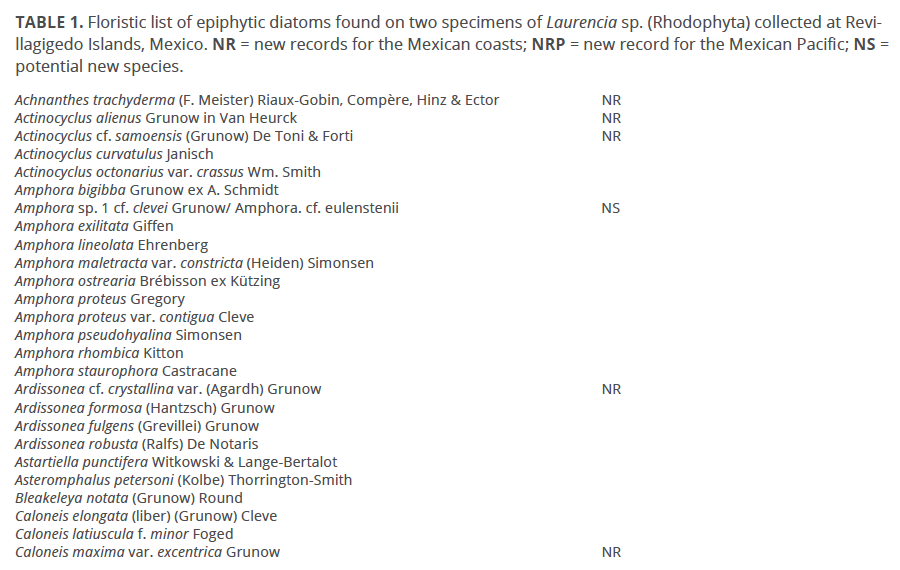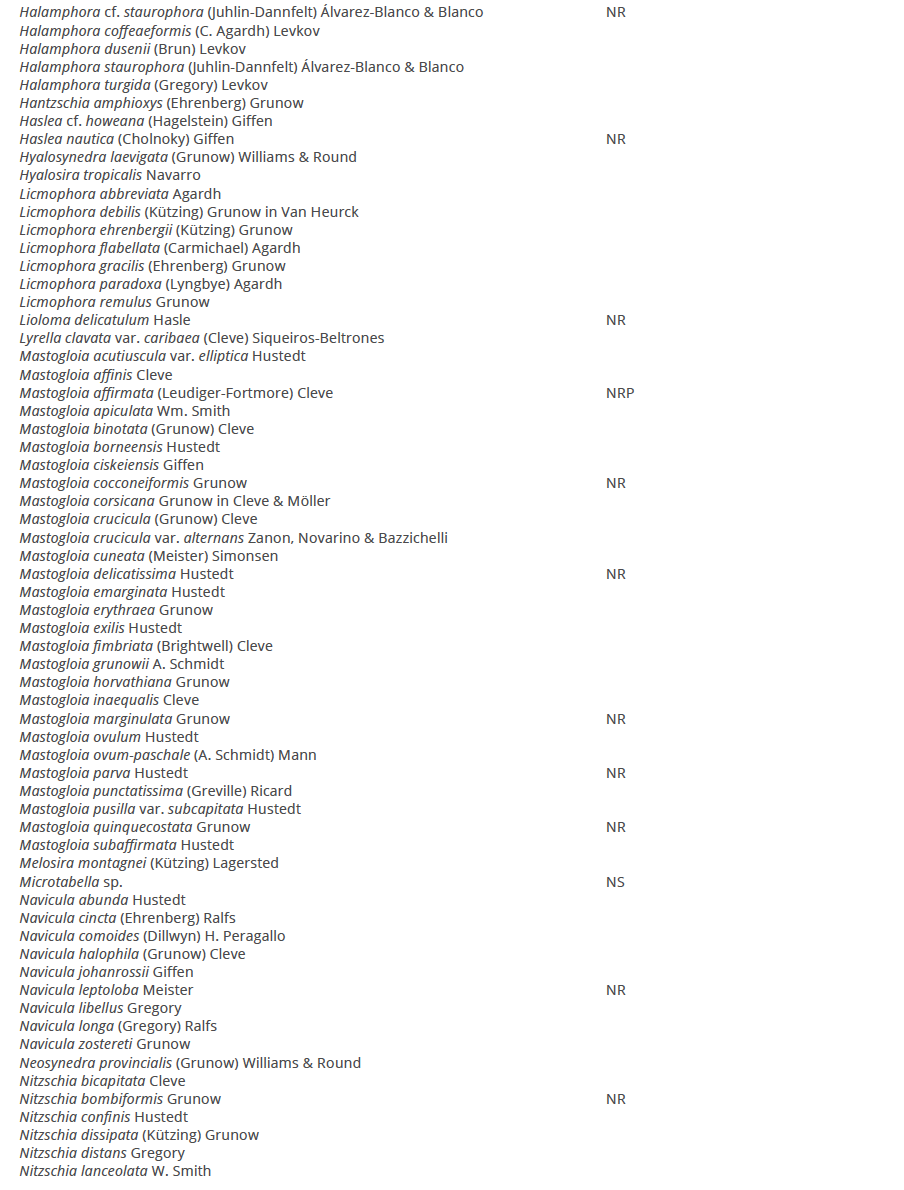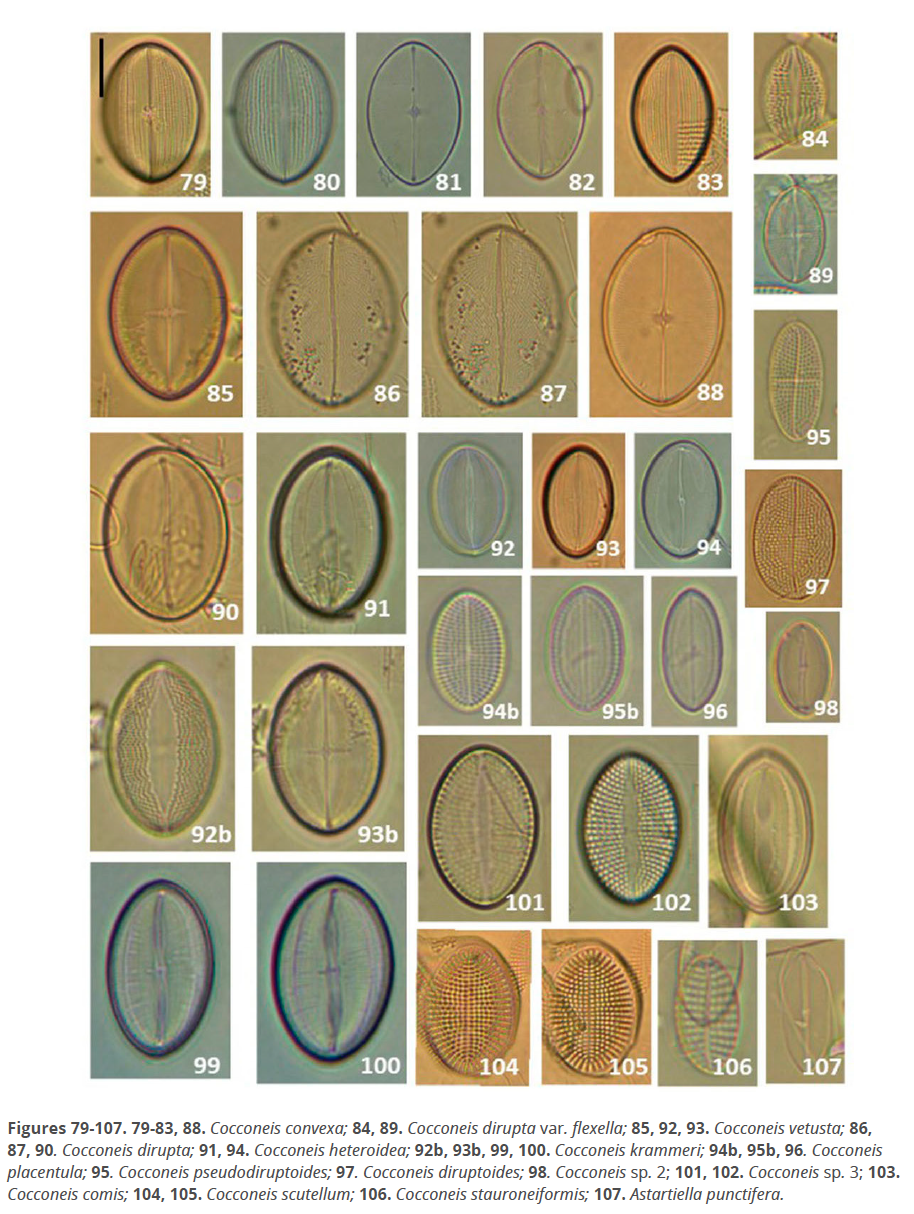Exploratory floristics of epiphytic diatoms from Revillagigedo Islands (Mexico)
Florística exploratoria de diatomeas epifitas de Islas Revillagigedo (México)
Siqueiros Beltrones, David A.1*, Yuriko Jocselin Martínez1 & Alejandro Aldana-Moreno2, 3
1 Departamento de Plancton y Ecología Marina, 2 Departamento de Pesquerías y Biología Marina, Centro Interdisciplinario de Ciencias Marinas-Instituto Politécnico Nacional. Av. IPN S/N, Col. Playa Palo de Santa Rita, La Paz, BCS. 23096. 3 Pelagios Kakunjá, Conservación Marina A.C., Laboratorio de Biotelemetría y Ecología de la Megafauna Marina. Email: dsiquei@gmail.com)
*Corresponding author: email: dsiquei@gmail.com
Siqueiros Beltrones, D.A., Martínez, Y.J. & A. Aldana-Moreno. 2019. Exploratory floristics of epiphytic diatoms from Revillagigedo Islands (Mexico). Cymbella 5(1): 98-123. http://cymbella.mx
Abstract
The feasibility of surveying substrates from remote localities such as Islas Revillagigedo (Mexico) promised both to increase the number of benthic diatom taxa hitherto known from Mexican littorals, and to demystify the endemic potential of the archipelago. Because the surface of rhodophytes harbor a great many diatom taxa, we expected that an exploratory survey using only two specimens of Laurencia sp. would provide an approximate estimate of the species richness of epiphytic diatoms living on macroalgae from the archipelago. Our survey yielded 208 diatom taxa (species and varieties) that, although most have been recorded elsewhere, it comprises 52 new additions to the benthic diatom flora for Mexican littorals, including 16 undetermined taxa that are likely new species. The high number of Mastogloia taxa, represented by 27 species and varieties, plus several other recorded taxa from the tropics, and the many new records not observed in the Mexican NW, suggests a strong tropical affinity of the diatom taxocoenosis that thrive in the Revillagigedo islands.
Key words: Bacillariophyta; diversity; new records, red algae; species richness.Resumen
La posibilidad de revisar sustratos de localidades remotas como las Islas Revillagigedo (México) prometía, tanto incrementar el número de taxones de diatomeas bentónicas conocidas hasta ahora en litorales mexicanos, como desmitificar el potencial endémico del archipiélago. Dado que la superficie de rodofitas sirve de sustrato a muchas especies de diatomeas, asumimos que una inspección exploratoria en solo dos talos de Laurencia sp. proveería un estimado aproximado de la riqueza de especies de diatomeas epifitas de macroalgas del archipiélago. La florística redituó 208 taxones de diatomeas, entre especies y variedades; y, aunque la mayoría han sido registrados en otras localidades, comprende 52 adiciones a la flora de diatomeas bentónicas de litorales mexicanos, incluyendo 16 taxones no determinados que quizá sean nuevas especies. El elevado número de taxones del género Mastogloia, representado por 27 especies y variedades, aunado a los varios taxones registrados en localidades tropicales, así como los nuevos registros hasta ahora no observados en el noroeste mexicano, sugieren una fuerte afinidad tropical de la taxocenosis de diatomeas epifitas que habitan en las Islas Revillagigedo.
Palabras clave: Algas rojas; Bacillariophyta; diversidad; nuevos registros; riqueza de especies.Introduction.
The high floristic potential of benthic diatoms for Mexican littorals has been recently confirmed. Studies in hitherto unexplored areas and the surveying of new substrata have yielded numerous new records (López-Fuerte et al. 2015; Martínez & Siqueiros-Beltrones 2018; Siqueiros Beltrones et al. 2017; Siqueiros Beltrones & Martínez 2017) that have enriched the current overall species list for the region (López-Fuerte & Siqueiros Beltrones 2016). This may be related to the great variety of substrata potentially used by benthic diatoms, which includes both live and inert surfaces. Among the former, many animals harbor high diversities of diatoms, but the surfaces of macroalgae provide by far a higher species richness of epiphytic diatoms which surpasses several hundreds of species. In spite of the latter, many macroalgae taxa are still to be surveyed for epiphytic diatom floristics.
In Mexico, most research on the subject has been carried out for the NW region and, although these are scarce there are even fewer for the tropical zones. Consequently, for the southern Gulf of Mexico only one ex profeso study on epiphytic diatoms of rhodophytes has been published. This exploratory study yielded 115 epiphytic diatom taxa from six rhodophyte species, that included six new records for Mexican waters (Siqueiros Beltrones & Martínez 2017). Thus, the possibility of observing substrata from remote tropical localities such as Islas Revillagigedo promises an increase in the number of new records of benthic diatoms for the Mexican littorals and the likeliness of new species. Likewise, it opens expectations on the particularities of benthic diatoms taxocoenoses as well demystification of the alleged endemism for the islands as marked by the Comisión Nacional de Areas Naturales Protegidas and the Secretaría de Medio Ambiente y Recursos Naturales, of Mexico (CONANP-SEMARNAT 2015).
Four islands make up the Revillagigedo archipelago, San Benedicto, Socorro, Roca Partida and Clarion (UNESCO 2018). Under the jurisdiction of the state of Colima, Mexico they are located 386 km south of Cabo San Lucas, Baja California Sur. Although on July 2016 the UNESCO declared it World Heritage Site, only recently (CONANP 2017) was there a previous study issued for justifying its declaration as a national park. In spite of the comprehensive character of the above study, much research is yet to be done in the archipelago, inasmuch its remote location contributes to the conservation of multiples habitats and distinct substrata used by benthic fauna and flora that are yet to be described.
A previous report on diatoms from the archipelago (Hanna & Grant 1926) deals with fossil forms. In this study, we focused on epiphytic diatoms living on red macroalgae, inasmuch the surface of macroalgae and particularly rhodophytes have been observed to harbor many diatom taxa (Siqueiros Beltrones & Argumedo Hernández 2014; Siqueiros Beltrones & Hernández-Almeida 2006; Siqueiros Beltrones & Martínez 2017). The benthic macroalgal flora for Revillagigedo Islands comprises at least 190 taxa, including 123 rhodophytes (Serviere-Zaragoza et al. 2007), although as much as 205 taxa (134 rhodophytes) have been identified (León-Tejera et al. 1996).
Seasonal variations in the region seem to be determined by the alternating influence of the California Current and the North-equatorial Current, whilst the rest of the year a transition between both states may be observed (Lluch-Cota et al. 1994). These environmental characteristics lead us to propose a hypothesis on the biogeographical affinity of the epiphytic diatom taxocoenosis, which in this case promised to be strongly tropical although with important temperate components.
Because the remoteness of the archipelago largely precludes access to the islands habitats in order to carry out a comprehensive sampling that is representative of the target taxa, we hoped that a small sample consisting of two macroalgae specimens collected ex profeso would provide an approximate idea of the species richness potential of the rhodophyte epiphytic diatoms for the islands. Thus, our objective was to construct an exploratory floristic list of epiphytic diatoms of rhodophyte macroalgae for the Revillagigedo archipelago that comprised as many taxa as could be surveyed to support further formal taxonomic and hypothesis driven studies on diatom floristics, ecology, and biogeography for the Revillagigedo Archipelago.
MATERIAL AND METHODS.
Two red algae specimens were collected manually by Scuba during the December 27-January 4, 2018 period at the rocky shore of San Benedicto Island (Revillagigedo Archipelago) at 15-25 m depth (Map 1). The specimens were sun-dried, transported in a plastic ziploc bag and identified in the laboratory following Abbot & Hollenberg (1976). Diatoms were brushed off from each specimen of red algae while rinsing with purified water. The resulting sample was placed in a 150-ml test tube and left to settle. Then, the sample precipitate was collected and oxidized with a mixture of commercial alcohol and nitric acid at a ratio of 1(sample): 2 (alcohol): 5 (acid), (Siqueiros Beltrones 2002). The oxidized material was rinsed repeatedly with purified water until it reached a pH ≥ 6. For each sample two double permanent slides were mounted using Pleurax (RI=1.7). Identification was done at 1000× under an Olympus CH-2 compound microscope with phase contrast illumination. Diatoms were identified following Cleve-Euler (1952, 1953a, 1953b, 1955), Desikachary (1988, 1989), Desikachary & Prema (1987), Desikachary et al. (1987), Foged (1975, 1978, 1984), Hernández-Almeida et al. (2013), Hernández-Almeida and Siqueiros-Beltrones (2008, 2012), Hustedt (1955, 1959, 1961-66), Joon et al. (2018), Hein et al. (2008), Loir and Novarino (2013), López-Fuerte et al. (2010), Moreno et al. (1996), Peragallo and Peragallo (1908), Siqueiros-Beltrones (2002, 2006), Siqueiros-Beltrones and Hernández-Almeida (2006), Siqueiros-Beltrones et al. (2014), Schmidt et al. (1874 -1959), Stepanek et al. (2016), Stidolph et al. (2012), Van Heurck (1881), Witkowski et al. (2000). Taxonomic status was updated according to the AlgaeBase web site (Guiry & Guiry 2018), and Round et al. (1990). A catalog of the recorded epiphytic diatoms was assembled with micrographs of specimens taken with a CMOS Konus digital ocular lens microscope at 1000×.
Introduction.
RESULTS.
A total of 208 (specific and infra-specific) epiphytic diatom taxa were identified in the samples from both specimens of Laurencia collected at Revillagigedo Islands; sixteen of these taxa could not be identified to species level and may represent new taxa. Also, 52 taxa are new additions to the diatom flora of the Mexican coasts and three to the Mexican Pacific coast: Cocconeis caribensis Romero et Navarro, Mastogloia affirmata (Leudiger-Fortmore) Cleve, and Synedrosphenia cuneata (Grunow) Peragallo (Table 1, Figs. 1-366). The genus with most species and infra-specific representatives was Mastogloia with 27 taxa.
DISCUSSION.
Previous floristic studies of benthic diatoms in unexplored areas of the Mexican littorals and the survey of new substrata have yielded numerous new records that have recently enriched the species inventory for the region (Estrada-Gutiérrez et al. 2017; López-Fuerte et al. 2016; López-Fuerte & Siqueiros Beltrones 2016; Martínez & Siqueiros Beltrones 2018; Siqueiros Beltrones & Argumedo-Hernández 2014; Siqueiros Beltrones & Martínez 2017; Siqueiros Beltrones et al. 2017). In this way, the first new diatom taxon for the Gulf of California was recently proposed: Halamphora primus López-Fuerte et Siqueiros Beltrones was collected from the skin of stone scorpion fish (López-Fuerte & Siqueiros Beltrones 2018). Thus, the survey of substrates from remote localities such as Islas Revillagigedo (Mexico) was expected to increase the number of taxa and to demystify their endemic potential. Said expectations are here supported by the new records of known diatom species, as well as the sixteen likely new taxa observed.
Our exploration yielded one of the highest species richness (S=208) ever recorded for two samples of epiphytic diatoms. In comparison, a single specimen of Ploclamium cartilagineum from the western coast of the Baja California Peninsula, heavily colonized with diatoms, yielded 46 taxa (Siqueiros Beltrones & Argumedo Hernández 2014), while in over eight samples of six rhodophyte taxa from southeastern (tropical) Mexico 115 taxa were identified (Siqueiros Beltrones & Martínez 2017). Another survey still, recorded 143 diatom taxa from ten specimens of Laurencia pacifica in five different dates (Siqueiros Beltrones & Hernández-Almeida 2006). Moreover, a much similar study carried out in Isla Guadalupe off Baja California, where transitional oceanographic conditions are characteristic, yielded less (119) taxa (including 11 % new records for Mexican littorals), although in many more samples (López-Fuerte et al. 2015). There, Mastogloia species, considered mostly of tropical affinity, comprised the higher number of species (13), whilst in the Revillagigedo Islands twice the number of species (27) of this genus were present. Thus, although the Revillagigedo Islands are located also within a transitional zone influenced by the California Current (CONANP-SEMARNAT 2015), the tropical component of the archipelago region does seem to be a major factor enhancing the species diversity of epiphytic diatoms.
Only one taxon, Grammatophora merletta Hanna & Grant, was recognized as previously recorded from the Revillagigedo Archipelago by Hanna and Grant (1926) who made a survey on diatoms from the Miocene. On the other hand, most of the identified diatom taxa in Revillagigedo islands have been recorded elsewhere in the Mexican Pacific, particularly in the NW littorals that harbor many temperate forms under transitional oceanographic conditions (López-Fuerte & Siqueiros Beltrones 2016). However, representatives of tropical affinity were also observed, such as the Mastogloia specific and infra-specific taxa (27). Plus, other tropical elements that were recorded previously only from the Gulf of Mexico such as Cocconeis caribensis, Mastogloia affirmata, and Synedrosphenia cuneata, and now recorded for the first time in the Mexican Pacific. This agrees with our working hypothesis. However, over 25 % of the taxa are new records hitherto not documented for Mexican littorals (López-Fuerte & Siqueiros Beltrones 2016; Martínez & Siqueiros Beltrones 2018; Siqueiros Beltrones & Martínez 2017; Siqueiros Beltrones et al. 2017) and whose biogeographic affinities are uncertain.
Our results may serve both to demystify the expected endemism and high species diversity of benthic diatoms in the archipelago, inasmuch for the latter the high species richness observed backs said assumption, but most of the recorded taxa are actually distributed worldwide. By contrast, the fact that ten taxa could not be identified after an exhaustive search leads us to infer that these represent new taxa that need formal taxonomic descriptions.
These results, derived from the few samples examined, suggest a likely occurrence of more biogeographycally isolated diatom taxa in the islands. As in the case of Grammatophora monilifera Tempere & Brun which has been considered solely as a fossil species (Guiry & Gury 2108) from Japan (Kociolek et al. 2019). However, although Desikachary (1987) recorded it (single image) in sediments from the Indian Ocean region, it was observed commonly in our samples.
In spite of the low number of hosts surveyed, this first floristic list of epiphytic diatoms of rhodophytes may serve as a reference for upcoming formal and hypothesis driven studies on diatom floristics, taxonomy, ecology and conservation, and biogeography for the Revillagigedo Archipelago. Undertaking the wanting diatom floristics may lead to expect finding over 500 epiphytic taxa on the 190 macroalgae taxa documented (Serviere-Zaragoza et al. 2007) in the archipelago, including a significant number of new and, likely, endemic diatom taxa that should require formal taxonomic treatment.
ACKNOWLEDGEMENTS.
The crew of Pelagios Kakunjá, Conservación Marina, A. C. and SOLMAR V provided support for collecting the macroalgae samples. Alejandra Pinón Gimate confirmed the identification of our rhodophyte specimens. The first author (DASB) is fellow of Comisión de Fomento a Actividades Académicas (COFAA) and Estímulos al Desempeño a la Investigación (EDI), Instituto Politécnico Nacional. The second (YJM) and third (AAM) authors received a postgraduate scholarship from CONACYT. Reviews by two anonymous referees are greatly acknowledged.
REFERENCES
Abbot I.A. & G. Hollenberg. 1976. Marine algae of California. Stanford University Press, Stanford.
Cleve-Euler, A. 1952. Die diatomeen Von Schweden und Finnland. Teil V. (Schluss.) Mit 46 Tafeln. Almqvist & Wiksells Boktryckeri Ab, Stockholm.
Cleve-Euler, A. 1953a. Die diatomeen Von Schweden und Finnland. Teil II. Araphideae, Brachyraphideae. Mit 35 Tafeln. Almqvist & Wiksells Boktryckeri Ab, Stockholm.
Cleve-Euler, A. 1953b. Die diatomeen Von Schweden und Finnland. Teil III. Monoraphideae, Biraphideae 1. Mit 41 Tafeln. Almqvist & Wiksells Boktryckeri Ab, Stockholm.
Cleve-Euler, A. 1955. Die diatomeen Von Schweden und Finnland. Teil IV. Biraphideae 2. Mit 50 Tafeln. Almqvist & Wiksells Boktryckeri Ab, Stockholm.
Comisión Nacional de Áreas Naturales Protegidas (CONANP). 2017. Estudio Previo Justificativo para la declaratoria del Parque Nacional Revillagigedo. Comisión Nacional de Áreas Naturales Protegidas, Secretaría de Medio Ambiente y Recursos Naturales, México.
Comisión Nacional de Áreas Naturales Protegidas - Secretaria de Medio Ambiente y Recursos Naturales (CONANP-SEMARNAT). 2015. Formulario de Nominación del Bien Natural Archipiélago de Revillagigedo para su Inscripción en la Lista del Patrimonio Mundial. Comisión Nacional de Áreas Naturales Protegidas - Secretaria de Medio Ambiente y Recursos Naturales, México.
Desikachary, T.V. 1988. Marine diatoms from the Indian Ocean. In: T.V. Desikachary. Ed. Atlas of Diatoms. Fasc. V. Madras Science Foundation, Madras, pp. 1-10.
Desikachary, T.V. 1989. Marine diatoms from the Indian Ocean. In: T.V. Desikachary. Ed. Atlas of Diatoms. Fasc. VI. Madras Science Foundation, Madras, pp. 1-27.
Desikachary, T.V., S. Gowthaman & Y. Latha. 1987. Diatom flora of some sediments from the Indian Ocean region. In: T.V. Desikachary. Ed. Atlas of Diatoms. Fasc. II. Madras Science Foundation, Madras, pp. 1-10.
Desikachary, T.V. & P. Prema. 1987. Diatoms from the Bay of Bengal. In: T. V. Desikachary, T. V. (Ed.). Atlas of Diatoms. Fasc. III et IV. Madras Science Foundation, Madras, pp. 1-10.
Estrada-Gutiérrez, K.M., D.A. Siqueiros-Beltrones & O.U. Hernández-Almeida. 2017. New records of benthic diatoms (Bacillariophyceae) for Mexico in the Nayarit littoral. Revista Mexicana de Biodiversidad 88: 985-987. doi.org/10.1016/j.rmb.2017.10.039
Foged, N. 1975. Some littoral diatoms from the coasts of Tanzania. Cramer, Vaduz.
Foged, N. 1978. Bibliotheca phycologica: Diatoms in eastern Autralia. Cramer, Vaduz.
Foged, N. 1984. Bibliotheca diatomologica: Freshwater and littoral diatoms from Cuba. Cramer, Vaduz
Guiry, M.D. & G.M. Guiry. 2018. AlgaeBase. World-wide electronic publication. National University of Ireland, Galway. http://www.algaebase.org. (Accessed on October 1, 2018).
Hanna, G D. & W.G. Grant. 1926. Expedition to the Revillagigedo Islands, Mexico, in 1925, II. Miocene marine diatoms from Maria Madre Island, Mexico. Proceedings of the California Academy of Sciences, series 4, 15: 115-193.
Hein, M.K., B.M. Winsborough & M.J. Sullivan. 2008. Bacillariophyta (Diatoms) of the Bahamas. A.R.G. Gantner Verlg K.G., Ruggell.
Hernández-Almeida, O.U. & D.A. Siqueiros Beltrones. 2008. Variaciones en asociaciones de diatomeas epifitas de macroalgas en una zona subtropical. Hidrobiológica 18: 51-61.
Hernández-Almeida, O.U. & D.A. Siqueiros Beltrones. 2012. Substrate dependent differences in the structure of epiphytic vs. epilithic diatom assemblages from the southwestern coast of the Gulf of California. Botanica Marina 55: 149-159.
Hernández-Almeida, O.U., J. A. Herrera-Silveira, & F. Merino-Virgilio. 2013. Nueve nuevos registros de diatomeas bentónicas de los géneros Climaconeis, Cocconeis, Licmophora, Talaroneis, Oestrupia, Petroneis y Synedrosphenia en la costa norte de la Península de Yucatán, México. Hidrobiológica 23: 154-168.
Hustedt, F. 1955. Marine littoral diatoms of Beaufort, North Carolina. Bulletin Duke University Marine Station, Duke University Press no. 6, Durham.
Hustedt, F. 1959. Die kieselalgen Deutschlands, Osterreichs and der Schweis. In: L. Rabenhorts. Ed. Kryptogammen-Flora. VII Band, II Teil. Koeltz Scientific Book, Leipzig.
Hustedt, F. 1961-1966. Die kieselalgen Deutschlands, Osterreichs and der Schweis. In: L. Rabenhorst. Ed. Kryptogammen-Flora. VII Band, IIITeil. Koeltz Scientific Book, Leipzig.
Joon Sang, P., C.S. Lobban & K.W. Lee. 2018. Diatoms associated with seaweeds from Moen Island in Chuuk Lagoon, Micronesia. Phytotaxa 351: 101–140. doi: 10.11646/phytotaxa.351.2.1
Kociolek, J.P., K. Balasubramanian, S. Blanco, M. Coste, L. Ector, Y. Liu, M. Kulikovskiy, N. Lundholm, T. Ludwig, M. Potapova, F. Rimet, K. Sabbe, S. Sala, E. Sar, J. Taylor, B. Van de Vijver, C.E. Wetzel, D.M. Williams, A. Witkowski, & J. Witkowski. 2019. DiatomBase. Grammatophora monilifera var. monilifera Tempère & Brun in Brun & Tempère, 1889. Accessed through: World Register of Marine Species (WORMS) at: http://www.marinespecies.org/aphia.php?p=taxdetails&id=975299. (Accessed on January 21, 2019).
León-Tejera, H., E. Serviere-Zaragoza & J. González-González. 1996. Floristic affinities of the Revillagigedo Islands, México. Hydrobiology 326-327: 159-168.
Loir, M. & G. Novarino. 2013. Marine Mastogloia Thwaites ex W. Sm. and Stigmaphora Wallich species from the French Lesser Antilles, Diatom Monographs Vol. 16. A.R.G. Gantner Verlag K.G., Ruggell.
López-Fuerte, F.O., Ma. C. Lora Vilchis, L. Veleva, D.A. Siqueiros-Beltrones, B.O. Arredondo Vega & M. Virgen Felix. 2016. Primeros registros de Nanofrustulum shiloi (Lee, Reimer & McEnery) Round, Hallsteinsen & Paasche y Nitzschia nienhuisii Sterrenburg & Sterrenburg (Bacillariophyceae; Ochrophyta) en aguas mexicanas. CICIMAR Oceánides 31: 35-41.
López Fuerte, F.O., D.A. Siqueiros Beltrones & J.N. Navarro. 2010. Benthic diatoms associated with mangrove environments in the northwest region of Mexico. Comisión Nacional para el Conocimiento y Uso de la Biodiversidad-Universidad Autónoma de Baja California Sur-Instituto Politécnico Nacional, México.
López-Fuerte, F.O., D.A. Siqueiros-Beltrones & R. Yabur. 2015. First record of benthic diatoms (Bacillariophyceae and Fragilariophyceae) from Isla Guadalupe, Baja California, México. Revista Mexicana de Biodiversidad 86: 281-292. http://dx.doi.org/10.1016/j.rmb.2015.04.016
López-Fuerte, F.O. & D.A. Siqueiros-Beltrones. 2016. A checklist of marine benthic diatoms (Bacillariophyta) from México. Phytotaxa 283: 201–258. http://dx.doi.org/10.11646/phytotaxa.283.3.1
López-Fuerte, F.O. & D. A. Siqueiros-Beltrones. 2018. Halamphora primus (Bacillariophyta): a new diatom species from the Gulf of California, Mexico. Phytotaxa 369: 287-294. https://doi.org/10.11646/phytotaxa.369.4.6
Lluch-Cota S. E., D. B. Lluch-Cota, D. Lluch-Belda & J. Bautista-Romero. 1994. Oceanografía. In: A. Ortega-Rubio & A. Castellanos-Vera. Eds. La Isla Socorro, Reserva de la Biósfera Archipiélago de Revillagigedo, México. Centro de Investigaciones Biológicas del Noroeste, S.C. and World Wildlife Fund. pp: 77-111.
Martínez, Y. J. & D. A. Siqueiros Beltrones. 2018. New records of benthic diatoms (Bacillariophyceae) taxa for Mexican coasts from the Gulf of California. Hidrobiológica 28: 141-145.
Moreno, J. L., S. Licea & H. Santoyo. 1996. Diatomeas del Golfo de California. Universidad Autónoma de Baja California Sur, La Paz.
Peragallo, H. & M. Peragallo. 1897-1908. Diatomées Marines de France et des Districts Maritimes Voisins. Text. J. Tempère (ed.), Micrographe-Editeur, à Grez-sur-Loing.
Round, F. E., R. M. Crawford & D. G. Mann. 1990. The diatoms: biology and morphology of the genera. Cambridge University Press, Cambridge.
Schmidt, A., M.V. Schmidt, F.V. Fricke, H. Heiden, O. Muller & F. Hustedt. 1874–1959. Atlas der diatomaceenkunde. Heft 1–120, Tafeln 1–460. Reisland, Leipzig.
Serviere-Zaragoza, E., R. Riosmena-Rodríguez, H. León-Tejera & J. González-González. 2007. Distribución espacial de macroalgas marinas en las islas Revillagigedo, México. Ciencia y Mar 11: 3-13.
Siqueiros Beltrones, D.A. 2002. Diatomeas bentónicas de la Península de Baja California; diversidad y potencial ecológico. Oceánides/CICIMAR, La Paz.
Siqueiros Beltrones, D.A. 2006. Diatomeas bentónicas asociadas a trombolitos vivos registrados por primera vez en México. CICIMAR Oceánides 21: 113-143.
Siqueiros Beltrones, D.A. & U. Argumedo Hernández. 2014. Particular structure of an epiphytic diatom assemblage living on Ploclamium cartilagineum (Lamoroux) Dixon (Rhodophyceae: Gigartinales). CICIMAR-Oceánides 29: 11-24.
Siqueiros Beltrones, D.A. & U. Argumedo Hernández. 2017. New records of benthic marine diatom taxa for Mexican littorals. CICIMAR-Oceánides 32: 59-62.
Siqueiros Beltrones, D.A., U. Argumedo Hernández & F.O. López Fuerte. 2017. New records and combinations of Lyrella (Bacillariophyceae; Lyrellales) in a coastal lagoon of the NW Mexican Pacific. Revista Mexicana de Biodiversidad 88: 1-20. http://dx.doi.org/10.1016/j.rmb.2017.01.017
Siqueiros Beltrones, D.A. & O.U. Hernández Almeida. 2006. Florística de diatomeas epifitas en macroalgas de un manchón subtropical. CICIMAR-Oceánides 21: 11-61.
Siqueiros Beltrones, D.A. & Y.J. Martínez. 2017. Prospective floristics of epiphytic diatoms on Rhodophyta from the southern Gulf of Mexico. CICIMAR-Oceánides 32: 35-49.
Stepanek, J.G., S. E. Hamsher, S. Mayama, D. H. Jewson & J. P. Kociolek. 2016. Observations of two marine members of the genus Cymbellonitzschia (Bacillariophyta) from Tokyo Bay, Japan, with the description of the new species Cymbellonitzschia banzuensis. Phycological Research 64: 26–34.
Stidolph, S.R., F.A.S. Sterrenburg, K.E.L. Smith & A. Kraberg. 2012. Stuart R. Stidolph Diatom Atlas. U.S. Geological Survey Open-File Report 2012–1163, available online at http://pubs.usgs.gov/of/2012/1163/.
UNESCO. 2018. Archipiélago de Revillagigedo. http://whc.unesco.org/en/list/1510. (Accessed on July 29, 2018).
Van Heurck, H. 1881. Synopsis des Diatomees de Belgique. Atlas, plates 31-77. Ducaju & Cie, Anvers.
Witkowski, A., H. Lange-Bertalot & D. Metzeltin. 2000. Diatom flora of marine coasts. pp. 1–925. In: H. Lange-Bertalot. Ed. Iconographia diatomologica. Koeltz Scientific Books, Königstein.
Revisores 2 revisores anónimos
Sometido: 21 de enero de 2019
Revisado: 6 de agosto de 2019
Corregido: 8 de agosto de 2019























